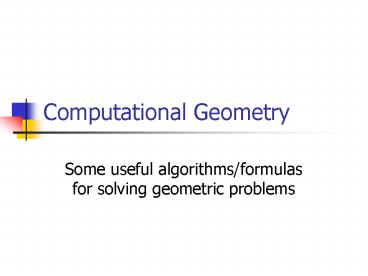Computational Geometry - PowerPoint PPT Presentation
Title:
Computational Geometry
Description:
Computational Geometry. Some useful algorithms/formulas for ... (x, y) Cartesian coordinates (r, T) Polar coordinates. Segments. Position of the end points ... – PowerPoint PPT presentation
Number of Views:111
Avg rating:3.0/5.0
Title: Computational Geometry
1
Computational Geometry
- Some useful algorithms/formulas for solving
geometric problems
2
Overview
- Representation
- Basic geometric problems
- Other issues
3
Representation
- Points
- (x, y) Cartesian coordinates
- (r, T) Polar coordinates
- Segments
- Position of the end points
- Lines
- 2-tuple (m, c) using y mx c
- 3-tuple (a, b, c) using ax by c
- Two points P0, P1 on the line using P(t)
(1-t)P0 t P1 - Polygon
- Ordered list of points
4
Basic geometric problems
- Area of polygon
- CCW
- Line segment intersection
- Distance between a point and a line
- Closest point
- Angle between two lines
- Point in a polygon
- Convex hull
5
Area of polygon
- Given a simple polygon, find its area.
- Area 1/2 (x1.y2 x2.y3 xn.y1)
- (y1.x2 y2.x3 yn, x1)
(x2, y2)
(x1, y1)
(xn, yn)
6
CCW
3
- Basic geometric primitive
- Returns 1 if the points are ccw
- Returns -1 if the points are cw
- Returns 0 if the points are collinear
- Area given in the previous slide is positive when
the points are listed in counter-clockwise
direction and negative otherwise
2
1
ccw(p1, p2, p3) returns 1
7
Line segment intersection (I)
- Given two line segments l1 and l2, determine if
they intersect ? - isIntersect ccw(l1.p1, l1.p2, l2.p1)
- ccw(l1.p1, l1.p2, l2.p2) lt 0
ccw(l2.p1, l2.p2, l1.p1)
ccw(l2.p1, l2.p2, l1.p2) lt 0
l1.p2
l2.p1
l2.p2
l1.p1
8
Distance between a point and a line
- Given a point and a line, determine the shortest
distance between them. - Select two points A, B on the line
- ½ AB h area of triangle ABP
P
h
B
A
9
Closest point (I)
- Given a line L and a point P, find the point on L
closest to P - Recall that if u is a unit vector and v is any
vector. The projection of v on u is given by
(u.v)u - u.v is the number k which minimized v ku
10
Closest point (II)
- The theorem in the previous slide can only be
applied to lines which pass through the origin - This is sufficient to compute the general case as
we can apply a translation if the line does not
pass through the origin
11
Angle between two lines
- Represent lines as vectors u (a, b) and v (c, d)
- Definition of dot product
- u.v uvcos T ac bd
- u sqrt(u.u)
- T cos-1(u.v / uv)
u
T
v
12
Point in a polygon (I)
- Given a point and a closed polygon, determine
whether the point lies inside the polygon. - Most algorithms extends a ray from the given
point and considers the interaction of the
polygon with the ray - Such algorithms needs to handle the following
boundary cases
13
Point in a polygon (II)
- A standard way to resolve this issue is to adopt
the following set of rules - Edge crossing rules
- an upward edge includes its starting endpoint and
excludes its endpoint - a downward edge excludes its starting endpoint
and includes its endpoint - horizontal edges are excluded
- the edge-ray intersection point must be strictly
right of the point P
14
Point in a polygon (III)
- One of the simplest algorithm is to compute the
winding number of the point
15
Point in a polygon (IV)
- Winding number
- number of times the polygon winds around the
point - Point is outside iff WN 0
- Upward edges gt WN
- Downward edges gt WN--
16
Point in a polygon (V)
- // Input P a point,//
V vertex points of a polygon with
VnV0// Return wn the winding number
(0 only if P is outside V)int
wn_PointInPoly(Point P, Point V, int n)
int wn 0 // the winding number
counter // loop through all edges of the
polygon for (int i0 iltn i) // edge
from Vi to Vi1 if (Vi.y lt P.y)
// start y lt P.y if
(Vi1.y gt P.y) // an upward
crossing if (ccw( Vi, Vi1,
P) gt 0) // P left of edge
wn // have a valid up
intersect else // Vi.y gt
P.y if (Vi1.y lt P.y) // a
downward crossing if (ccw( Vi,
Vi1, P) lt 0) // P right of
edge --wn //
have a valid down intersect
return wn
17
Convex hull (I)
- Given a set of points, determine the smallest
convex set containing all the points - A set S is convex if whenever two points P and Q
are inside S, then the whole line segment PQ is
also in S
18
Convex hull (II)
- One simple algorithm is Graham Scan, often cited
as the first computational geometry algorithm - Pseudocode
- Select the lowest leftmost point P0 in S
- Sort the rest of the points in S according to the
angle made with P0, break ties base on distance
to P0 - Let P0..n-1 be the sorted array of points
- Create an empty stack ST
- ST.push(Pn-1) //Pn-1 must be on the hull
- ST.push(P0) //P0 must be on the hull
- For i from 2 to n 1
- Let PT1 denote the topmost point on ST
- Let PT2 denote the second topmost point on ST
- while (ccw(PT2, PT1, Pi) lt 0) ST.pop()
- ST.push(Pi)
19
Other issues
- Case analysis
- Use of floating point numbers
- Overflow
20
References
- http//softsurfer.com/, Dan Sunday
- Algorithms, Robert Sedgewick
- Programming Challenges, Skiena and Revilla































